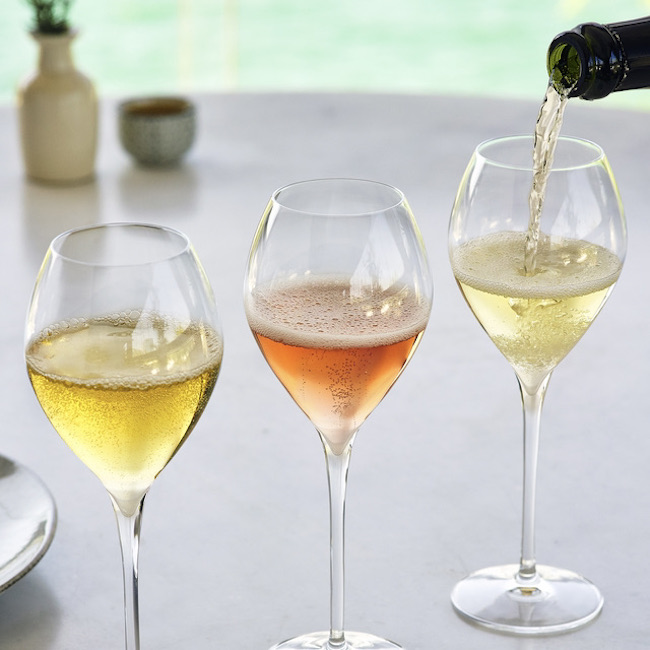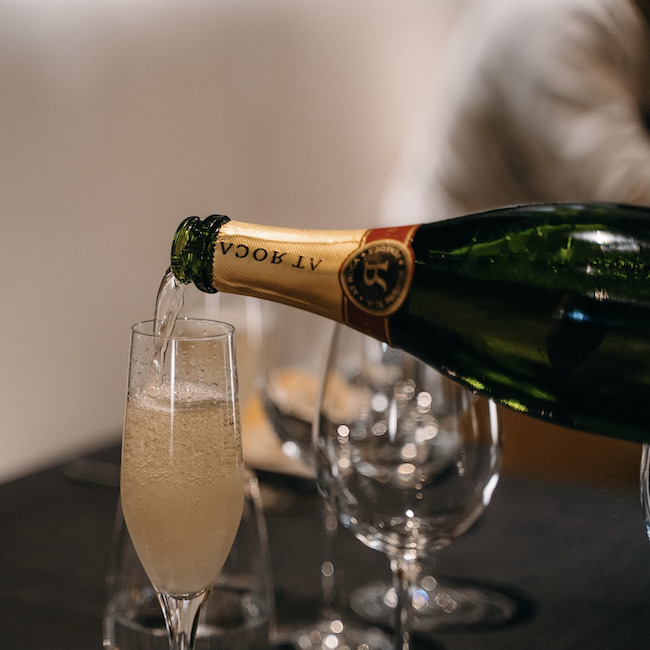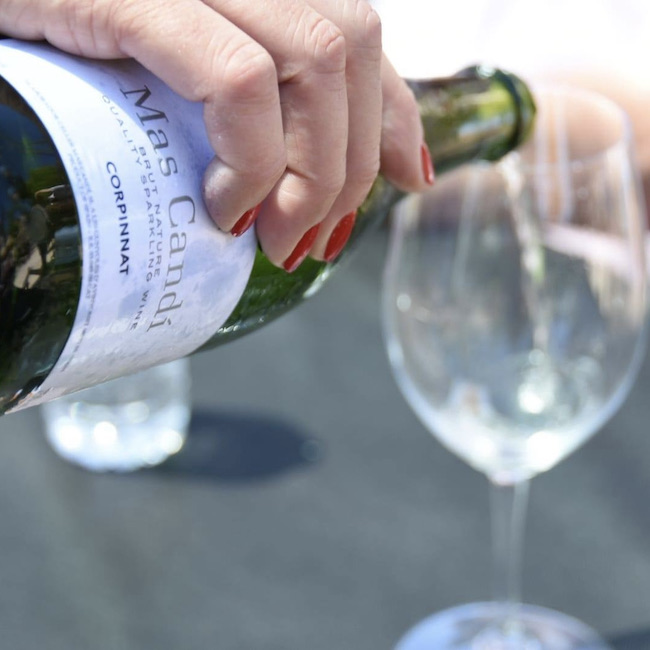by Ferran Centelles - @ferrancentelleswine
.png.transform/rendition-xs/image_image%20(1).png)
We travel to Penedès to learn about the different sparkling wines produced there and their different appellations

by Ferran Centelles - @ferrancentelleswine
A glass of sparkling wine, according to renowned "bubble scientist" Gérard Liger-Belair, contains about two million bubbles. We like bubbles. They confer prestige, enrich the social experience, enable versatile pairings, and are present during the celebration of important dates. We hear a "pop!" and start salivating, almost like Pavlov's dogs, because the sound leads us to anticipate an exclusive experience. Bubbles inspire and spread happiness.
In Spain, the winds of change have been blowing in recent years. Sometimes, we Homo sapiens have an innate resistance to change. This is normal, because tradition is associated with past experience and is justified by cultural and, above all, sentimental support.
A bit of history
The story of Spanish sparkling wine dates back to at least 1872. That was the year that Josep Raventós Fatjó traveled to France to learn about the "Champagne Method" (méthode champenoise) and brought the production of "Xampany" back with him to the Penedès region.
However, it wasn't until 1928 that "cava" was first mentioned, an event attributable to the Mestres winery. Until then, as visible on the famous 1887 Llopart label, the appellations were somewhat more generic, although very precise, for example "Espumós." It was Mestres again which eliminated the addition of sugar in the expedition liqueur, in 1948. This simple decision paved the way for Brut Nature wines, which represent both a culture and a territory. Today, Brut Nature are considered the most prestigious wines, even in Champagne, where they have also adopted and embraced this decision, especially small cult winemakers.
1951 was Bartomeu and Josep Lluís Gramona's year. They were the architects of the first III Lustros: the first great long-aged Cava. Because of that, today Gramona is considered one of the best sparkling wine producers in the world.
A few years later, in 1955, Josep Maria Capellades, from the Recaredo family, decisively introduced the use of cork stoppers to produce these long-aged wines. It was a decision that we know completely changed the evolution of these wines, taking them to heights unattainable by any other means.
Finally, in 1972, the Regulatory Board for Sparkling Wines was created, and the word Cava was legally approved to designate these Spanish sparkling wines. It wasn't until 1986 that the Cava DO region was demarcated and its name associated with the so-called "traditional method" of producing these wines.
As we know, this demarcation included several Spanish regions. The historical center was Penedès (Barcelona and Tarragona), but it also included several cities, both in Catalonia (Girona, Lleida) and the rest of Spain (Álava, Navarre, Zaragoza, La Rioja, Badajoz, and Valencia). In part, this was because some producers, like the Raventós family, also produced sparkling wines in areas outside the center of Penedès; other wineries, such as Bodegas Bilbaínas, had been making sparkling wines since 1890. In the end, a compromise was reached. That being said, in Spain at the beginning of the 20th century, there were other areas where sparkling wine was being produced, especially in the north. However, these were initiatives that were not formally established nor did they ever fully develop. Little by little, they were abandoned. However, in recent decades, these sparkling wines have returned to the market with undeniable quality and demand.
Returning to Cava, this milestone was particularly important because, in a world as romantic as wine, when the topic of prestige comes up, geographical delimitation matters, and it matters a lot. That is to say, the fact that the term cava could be used in areas so far apart is not a problem per se, but the fact that producers could not differentiate their production area from others was the beginning of all future problems.

Most of us know the story of Pepe Raventós, owner of the winery Raventós i Blanc. In 2012, he decided to leave Cava DO to produce sparkling wine under the generic term Vino Espumoso de Calidad (quality sparkling wine) for his wine project in Conca del Riu Anoia, in the historic heart of Penedès. Raventós i Blanc is a leading winery in biodynamics and in the recovery of animal labor in the vineyard. But if Pepe Raventós is known for anything, it's for his philosophy about the soil. He dreams of a quality system organized in villages and crus because, according to him, it's the ideal way for the "territory to come out on top." I have always liked this territorial segmentation. Today, his Xarel-los and Macabeus have flooded several reputable markets, such as New York.
The birth of the Classic Penedès
It was the start of diverging paths. In 2014, several wineries decided to join forces under the Classic Penedès label and leave Cava DO. Once again, they're wineries located in the Penedès region although, in this case, the idea was not to create a new brand but, rather, to be included under Penedès DO. There are 16 well-known wineries, among them Celler Colet, Albet i Noya, Mas Bertrán, AT Roca, Loxarel, Mas Comtal, and Heretat MontRubí. Together they produce a million bottles. I like that they have also recognized the Ancestral Method as an alternative in producing quality sparkling wines. In this method, the first (and only) alcoholic fermentation is completed in the bottle that will be released on the market; as a result, there's only one fermentation, and no sugar or expedition liqueur is added.
I also like that these wineries can produce other sparkling wines outside Classic Penedès, which affords them freedom and, with it, the capacity to innovate and adapt. Let's imagine, for example, that they wanted to make experimental sparkling wines (without added sulfites, in demijohns, orange wines, etc.). Other DOs would require the creation of two different companies and, sometimes, even require completely separate buildings and facilities to be built; this is not the case in DO Penedès.
This does not lead to chaos. Any winery that wants to do this must guarantee the use 100% organic grapes. Additionally, the minimum aging period is 18 months, and absolutely all of these wines must indicate the vintage. It's a clear commitment to the winemaker's mindset.

The arrival of Corpinnat
More change came along in 2019. That year, several historic wineries embarked on their journey under Corpinnat, a collective European Union brand. Basically, the brand is privately and equally owned by the companies that comprise it and it has EU approval. It is by no means a foreign concept to the world of wine. Rioja wine began its journey in the same way at the beginning of the 20th century and later became a DO in its own right.
Corpinnat currently comprises 11 wineries, which together produce 2.5 million bottles. New owners can join as long as they agree to comply with the brand's requirements, although the barriers to entry are high. For example, there are two annual audits, one documentary and the other a visit during the harvest. Moreover, the basic requirements are that 90% of production must be traditional varieties; they must use organic farming; the grapes must come entirely from the historic heart of Penedès; harvesting must be manual; only the traditional method is authorized; all the wine must be made on the premises; and aging must be 18 months as a minimum.
Although it's only been around for 5 years, it's already a recognized brand and is even included on restaurant wine lists with its own name and distinguishable from other sparkling wines.
Cava, a new path
The response from Cava DO was formalized in 2022. It was then that the Regulatory Board, led by its affable, talkative chairman, Javier Pagés, proposed a new regulation in which, ideally, all the producers of quality sparkling wine mentioned in this article could find a specific niche in line with their interests.
We cannot deny that the term Cava is already part of culture and tradition. It's a powerful concept on which more than 6,500 wineries of various sizes depend, and in which everyone wants to be recognized with the prestige they deserve. The second fermentation in the bottle is a craft that we must value and honor. It's also true that, due to its large size, this is an appellation with great diversity. There are four main producers: Freixenet, Codorniu, Jaume Serra, and Vallformosa, but there are also other smaller ones. It's also worth mentioning that Cava offers an immense range of wines, with exceptional producers such as Juvé & Camps, Mestres, Guillera, Rovellats, Maria Rigol, Vins del Cep, Alta Alella, Parxet, Carles Andreu, Domino de la Vega, Pago de Tarsys, and Bodegas Hispano+Suizas. This diversity of business and market vision deserves to be maintained and strengthened and there should also be a commitment to segmentation and differentiation.

Among the new measures adopted is the long-awaited establishment of zones and subzones. The proposal includes 4 zones: Comtats de Barcelona, Valle del Ebro, Viñedos de Almendralejo, and Zona de Levante. In turn, Comtats de Barcelona is divided into several subzones. Valls d'Anoia Foix, with its characteristic blends of Xarel-lo, Macabeu, and Perellada; Serra de Mar, with its distinctive proximity to the sea and the Sauló soil; Conca de Gaià, with the predominance of Macabeu; Serra de Prades and the delicious rosés of Trepat, Pinot Noir, and its delicate Parelladas; and Pla de Ponent, which its Chardonnay and Pinot Noir. In the Ebro Valley, there are two established subzones: Cierzo Valley and Alto Ebro. The Almendralejo vineyards and Zona de Levante do not have subzones at the moment.
Additionally, the DO has created two perfectly different worlds in terms of aging periods. On the one hand, there are Guarda wines, with a minimum of 9 months of aging, and there are Superior Guarda wines, which must guarantee a minimum aging of 18 months. The latter category includes Reserva, Gran Reserva, and Paraje Calificado cavas. In addition, the Cavas de Guarda Superior require the vineyard to be at least 10 years old, the grapes to be grown 100% organically, and the vintage to be referenced on the label.
Following these measures, Cava DO has experienced substantial growth in sales. The concept of Holistic Winemaker has also been created and applies to those wineries that produce their own base wine. It refers to those producers who want to emphasize that they do not buy partially-produced wine; they make it all from scratch. Of course, this concept may also appear on the label for consumers to see.
I think that people are willing to pay for quality products, and they definitely have a market. At the high end of the market where we are, and with the quality and price we offer, we have little competition.
I would like to thank Pepe Raventós, Ton Colet (Clàssic Penedès), Ton Mata (President of Corpinnat), and Javier Pagés (Chairman of Cava DO) for providing me with the information I needed for this article.